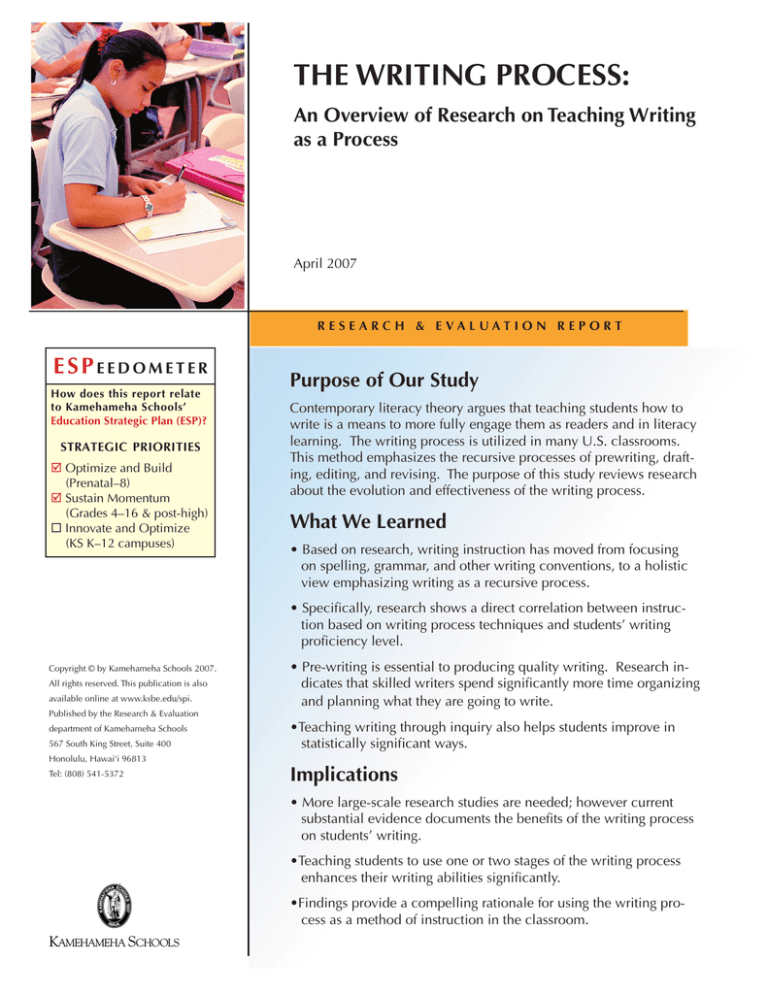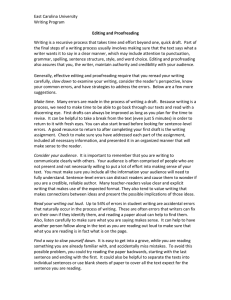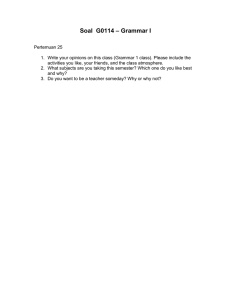
THE WRITING PROCESS:
An Overview of Research on Teaching Writing
as a Process
April 2007
RESEARCH & EVALUATION REPORT
ESPEEDOMETER
How does this report relate
to Kamehameha Schools’
Education Strategic Plan (ESP)?
STRATEGIC PRIORITIES
þ Optimize and Build
(Prenatal–8)
þ Sustain Momentum
(Grades 4–16 & post-high)
¨ Innovate and Optimize
(KS K–12 campuses)
Purpose of Our Study
Contemporary literacy theory argues that teaching students how to
write is a means to more fully engage them as readers and in literacy
learning. The writing process is utilized in many U.S. classrooms.
This method emphasizes the recursive processes of prewriting, drafting, editing, and revising. The purpose of this study reviews research
about the evolution and effectiveness of the writing process.
What We Learned
• Based on research, writing instruction has moved from focusing
on spelling, grammar, and other writing conventions, to a holistic
view emphasizing writing as a recursive process.
• Specifically, research shows a direct correlation between instruction based on writing process techniques and students’ writing
proficiency level.
Copyright © by Kamehameha Schools 2007.
All rights reserved. This publication is also
available online at www.ksbe.edu/spi.
Published by the Research & Evaluation
department of Kamehameha Schools
567 South King Street, Suite 400
Honolulu, Hawai‘i 96813
Tel: (808) 541-5372
• Pre-writing is essential to producing quality writing. Research indicates that skilled writers spend significantly more time organizing
and planning what they are going to write.
•Teaching writing through inquiry also helps students improve in
statistically significant ways.
Implications
• More large-scale research studies are needed; however current
substantial evidence documents the benefits of the writing process
on students’ writing.
•Teaching students to use one or two stages of the writing process
enhances their writing abilities significantly.
•Findings provide a compelling rationale for using the writing process as a method of instruction in the classroom.
Teaching Literacy through Writing:
An Overview of Research on Teaching Writing as a Process
Introduction
In today’s society, the act of writing is ingrained in every aspect of our lives and will continue to
shape human interaction as we head full force into the 21st century. The ability to write
articulately gives one the power and opportunity to share and influence thoughts, ideas, and
opinions with others, not only in day-to-day situations, but across time and space. As Mary Heller
writes, “The value that we place on reading and writing arises out of our shared need to be literate
people, this is a function of our society and of our culture” (1991, p.13). As writers, it is important
to produce quality works, and as educators, we have learned a great deal about what it means to
teach others to do the same. This brief offers an overview of research and best practice in teaching
the writing process.
Teaching Writing: Grammar versus Content and Style
Contemporary literacy theory argues that teaching students how to write is a means to more fully
engage them in literacy learning. However, this was not always the case. Fifty years ago, writing
was taught via the technical aspects of proper grammar, spelling, punctuation, and other
conventions. Grammar instruction, or essentially “how the English language works,” was thought
to be essential to learning how to write and therefore, a principal focus in teaching writing
(Hillocks, 1987). Eventually, this rote approach came under increasing skepticism because it
failed to engage and inspire student learning (Hicks, 1993; Hillocks, 1986).
Since then, research has helped identify more effective ways to improve the quality of writing. An
early review of the literature found that teaching and studying grammar had no effect on the
quality of one’s writing (Braddock, Lloyd-Jones, & Schoer, 1963). This conclusion was further
supported by a carefully designed three year study in New Zealand. The study examined the
effects of exposing randomly assigned students to intensive grammar instruction taking up the
major part of the day compared to a control group of other students who did not have the
treatment ( Elley, Barham, Lamb, & Wyllie 1976). At the conclusion of the study, researchers
found no statistically significant differences in writing quality between the grammar-focused
treatment groups and the no-grammar treatment groups.
Further support of these findings emerged in an exhaustive research review by Hillocks (1987).
After reviewing thousands of studies, the author concluded that studying grammar does not
increase writing quality. He argues that these findings are not unexpected because, although
knowledge of grammar is important to proper writing, the way that content is produced is not
dependent upon correct grammar, but is more of an intuitive process. Furthermore, grammar is
corrected, changed and accounted for during the editing or proofreading stages of the writing
process, two stages believed to have little or no influence on the content or style of writing
(National Center for Educational Statistics, 1996). Subsequent research shows that skilled writers
focus more on content and organization, whereas less experienced writers are more concerned
with writing mechanics such as spelling or diction (Hillocks, 1986).
1
The Writing Process Today
Writing instruction began to change throughout the United States as teachers found more holistic
approaches to teaching writing (McCarthey, Hoffman, Stable, Elliott, Dressman, & Abbott, 1994).
Responding to the need for innovative instruction and pedagogies, the last two decades saw an
emergence of new practices that moved beyond rote repetition and technical instruction. Instead,
writing was taught as a vehicle for creative expression and critical thought. Rather than focusing
on spelling, grammar, and other writing conventions, the holistic process emphasizes the actual
process of writing. It concentrates on writing as a recursive process in which writers have the
opportunity to plan, draft, edit, and revise their work (Hillocks, 1987; Murray, 1982). The writer is
taught to review and revise several drafts, which enables and encourages new ideas. Grammatical
changes and conventional editing occur during the revision or editing stage (Ballator, Farnum, &
Kaplan, 1999; Flower & Hayes, 1981). Furthermore, since grammar and conventions are not the
focus of writing, the writing process may be adapted for use even with young writers in
kindergarten (Sealey, Sealey, & Millmore, 1979).
Writing is a uniquely individual undertaking and the same individual may use different methods to
express him or herself. Characteristically, the writing process approach recognizes that there are
many stages to writing and that these stages are fluid and overlapping (Bereiter & Scardamalia,
1983; Flower & Hayes, 1980; Murray, 1982). However, researchers and educators have identified
several logical steps that most writers go through, displayed in Figure 1.
Figure 1. The Writing Process1
Pre-writing
Drafting &
Writing
Sharing &
Responding
Revising &
Editing
Publishing
-“Getting ready
to write”
-Decide on a
topic
-Brainstorm
-Organize ideas
-Write and
refine
paragraphs
-Focus on
communication
of meaning
-Share work to
gain feedback
-Peer editing
-Writing
Workshops
-Revise content
-Proofread for
writing
conventions
-Text
reorganization
-Celebrate and
showcase
finished
products
-Build
confidence in
students as
writers
Existing Research about the Writing Process
Longitudinal brain research using neural imaging techniques demonstrates that whereas speech is
a very natural developmental process in human cognition, reading and writing require specific
training to achieve sophisticated development (Pugh et al., 2000). Studies to date indicate that the
writing process is one effective way to teach students to be good writers. (Flower & Hayes, 1981;
Greenwald, Persky, Campbell, & Mazzeo, 1999; Unger & Fleischman, 2004; National Center for
Education Statistics, 1996). Students are taught how to share and communicate their ideas through
1
Based upon research by Graves, 1983, 1991; Tompkins and Hoskisson, 1995; and Poindexter and Oliver, 1999.
2
words. In some classrooms, they share their work with peers through writing workshops and peer
editing, teaching them to recognize the value of writing and the purpose in creating a solid and
substantial work (Graves, 1983).
Pre-writing
Pre-writing, or planning out what is going to be written, is an essential step in the writing process
and should account for 70 percent of the writing time (Murray, 1982). Research indicates that
skilled writers spend significantly more time organizing and planning what they are going to write
(Hillocks, 1986). Most students, however, spend on average only about 3 minutes to prepare for
their writing (National Center for Educational Statistics, 1996). Students spend little time thinking
and planning how to express their thoughts before writing them down and therefore are not
accessing information and ideas that could possibly enhance their writing.
Re-writing
An important component to the writing process is its recursive nature, which allows writers to
revise their work continually. Evidence shows that writers not only revise what they are writing,
but also revisit their goals and plans for writing. This process allows writers to take into account
new ideas and thoughts and to have the opportunity to incorporate it into their writing. Research
by Bereiter et al. (1982) demonstrates that the processes involved in writing are hierarchically
related and notably recursive. The research team also found that children have much more
extensive knowledge about a topic than that reflected in their typical writings. They argue that
when children stop writing it is not because they run out of things to say, but because they do not
yet have adequate methods of articulating what they know. This research informs how we teach
writing, because by allowing students to write and rewrite, we are helping them learn how to tap
into their knowledge
Writing
As methods of teaching writing have evolved,
significant research has gone into understanding the
process that a writer goes through when composing
material and how to teach writing most effectively.
In an effort to synthesize the findings, one
comprehensive review looked at 2,000 studies
focused on identifying school instructional methods
that most successfully enhanced writing ability
(Hillock, 1987). Several hundred of these studies
used experimental treatments and interventions.
After rigorous screening, meta-analysis was
conducted on 60 of the latter studies containing
variables that could be compared across studies.
The meta-analysis revealed that teaching through
inquiry was the instructional method with the
greatest impact on the quality of students writing (see Figure 22). In this method, students use sets
2
Figure2 is taken from Hillocks’ Synthesis of Research on Teaching Writing (1987, p.75), and shows graphically his analysis of six instructional
focuses. These are the reported results in answer to his research question, “What is the difference between the experimental groups’ gains and the
control groups’ gains in studies having a particular focus in common among the experimental groups?” These effect sizes are reported in
standard deviations.
3
of data and, in a structured manner, incorporate them into their writing. Students may record,
describe, and present evidence while taking into account set criteria. For example, students may
be given information about a particular subject, such as pollution, prison rebellion, etc, and then
be asked to consider ways to help solve the problem. This inquiry process leads students to
develop better ideas, produce stronger support and evidence, and recognize and address positions
that are in opposition to them.
The research findings indicate that having students go through the steps of observing and writing
had greater impact on the quality of writing than did more traditional teaching using model
writings. In fact, teaching through inquiry was 3.5 times more effective in improving writing
quality than free writing techniques and more than 2.5 times more effective than the traditional
study of model writing. However, consistent with earlier research, Hillocks also found that
studying model writings or presenting students with good pieces of writing was significantly more
effective in improving the quality of writing than was studying grammar.
Additionally, using sentence combining strategies to teach writing also showed positive effects
(Hillocks, 1987). Directly teaching students how to achieve more complex syntactic structures
enhances their writing quality and sophistication.
Large-Scale Studies on the Writing Process
Research using the National Assessment of Educational Progress (NAEP) writing assessments is
consistent, showing a direct correlation between writing proficiency and teaching through process
writing (National Center for Education Statistics, 1996). The NAEP has administered nationwide
writing assessments to students for many years. Researchers analyzed responses from pre-writing
activities and writing exercises, and collected information about students’ exposure to various
methods of writing instruction. The results provide valuable information for educators who teach
writing.
The 1992 NAEP writing assessment asked students about how much emphasis teachers placed on
various components of the writing process and examined differences in writing scores based on
the information. Students reported how many times their teachers asked them to complete the
following aspects of the writing process: planning, defining the audience and purpose, using
outside resources, and composing more than one draft. The results indicated that students who
were more often exposed to these methods had higher than average writing scores than those
students who used the techniques less often (National Center for Education Statistics, 1996).
In 1998, NAEP surveyed approximately 160,000 students nationwide, and found that school and
home factors also affect students’ writing performance. Again, pre-writing exercises were the most
important factor in helping students to improve their writing. Statistics show that students whose
teachers talked to them beforehand about what to write scored higher than those students whose
teachers never talked to them in advance. Findings also showed evidence that students who visibly
planned out their writing scored higher than students who did no planning before writing. Having
students save their work in portfolios and requiring the use of computers in at least one stage of the
writing process were two other factors that contributed to higher writing scores. From these
studies, researchers concluded that higher than average writing scores were attributable to writing
techniques defined as the writing process (Greenwald et al., 1999).
4
The Need for More Research and Continuous Improvement
Although there is a wealth of knowledge to be gained from these research studies, there are some
limitations to which these findings can be extended. The NAEP looked only at writing process
techniques, which although effective, may not be the only way to improve students’ writing. It is
important to note that there are variables and factors that are unaccounted for in the NAEP study.
For example, a small scale study done by Stahl, Pagnucco, & Suttles (1996) found no difference in
student writing ability produced by process versus traditional teaching methods after controlling
for reading. This serves as a reminder that there may be many unexplored contextual and social
variables that may influence writing proficiency (Unger, 2004).
In addition, aside from NAEP’s study, large-scale writing process studies do not exist. Although
many smaller studies have been done at the classroom level, the results are challenged by small
sample size and limited generalizibility (Langer, 2001; Stahl, Pagnucco, & Suttles, 1996).
Conclusion and Implications
Writing instruction has come a long way. It has evolved from a rote, traditional method with an
emphasis on writing conventions, maturing into a process that is able to accommodate a writer’s
need to plan, brainstorm, seek feedback, and revise their work. Most importantly, however,
substantial research has helped inform the way writing is taught.
The discussion here suggests that although there is a need for more research including large-scale
studies, substantial evidence documents the benefits of the writing process to student writing. A
few key determinants of producing quality writers stand out, including teaching students how to
plan for writing (via pre-writing), to combine sentences, and to engage in the process of inquiry as
they learn to write. Teaching students to use even one or two stages of the writing process
enhances their writing abilities significantly. Together, these findings provide a compelling
rationale for using the writing process as a method of instruction in all classrooms and in so doing,
helping our children develop the skills they need to communicate for the future.
5
References
Ballator, N., Farnum, M., & Kaplan, B. (1999). NAEP 1996 trends in writing: Fluency and
writing conventions (NCES 1999-456).
Bereiter, C. & Scardamalia, M. (1982). From conversation to composition: The role of
instruction in a developmental process. Advances in Instructional Psychology, 2.
Braddock, R., Lloyd-Jones, R., & Schoer, L. (1963). Research in written composition. Urbana,
IL: National Council of Teachers of English.
Elley, W., Barham, H., Lamb, H. & Wyllie, M. (1976). The role of grammar in secondary
school English curriculum. New Zealand Journal of Educational Studies, 10(1), 26-42.
Flower, L.S., & Hayes, J.R. (1981). A cognitive process theory of writing. College Composition
and Communication, 32(4), 365-387.
Graves, D.H. (1983). Writing: Teachers and children at work. Portsmouth, NH: Heinemann.
Graves, D.H. (1991). Build a literate classroom. Portsmouth, NH: Heinemann.
Greenwald, E.A., Persky, H.R., Campbell, J.R., & Mazzeo, J. (1999). The NAEP 1998 writing
report card for the nation and the states (NCES 1999-462).
Heller, M. (1991). Reading-writing connections: From theory to practice. New York, NY:
Longman.
Hicks, J.R. (1993). Let’s get serious about teaching children to write. Lanham, MD: University
Press.
Hillocks, G. (1986). Research on written composition (Urbana, IL: National Conference on
Research in English and ERIC Clearinghouse on Reading and Communication Skills),
Chapter 1.
Hillocks, G. (1987). Synthesis of research on teaching writing. Educational Leadership, 44(8),
71-82.
Langer, J. (2001). Beating the odds: Teaching middle and high school students to read and
write well. American Educational Research Journal, 38(4), 837-880.
McCarthey, S.J., Hoffman, J.V., Stable, D., Elliott, B., Dressman, M., & Abbott, J. (1994). “Very
sweet, but very, very slow”: How teachers’ “Ways of Knowing” are reflected in their
assumptions about students. Unpublished paper, University of Texas, Austin.
Murray, D.H. (1982). Learning by teaching. Montclair, NJ: Boynton/Cook.
National Center for Education Statistics. (1996). Can students benefit from process writing?
(NCES 96-845). NAEP-ACTS, 1(3). Washington, DC. Available:
http://nces.ed.gov/pubs96/web/96845.asp
6
Poindexter, C.C. & Oliver, I.R. (1999). Navigating the writing process: Strategies for young
children. Reading Teacher, 52(4), 420-424.
Pugh, K.R., Mencl, W.E., Jenner, A.R., Katz, L., Frost, S.J., Lee, J.R., Shaywitz, S.E., &
Shaywitz, B.A. (2000). Neurobiological studies of reading and reading disability. Journal of
Communication Disorders, 34, 479–492.
Sealey, L., Sealey, N., & Millmore, M. (1979). Children’s Writings. Newark, DE: International
Reading Association.
Stahl, S., Pagnucco, J., & Suttles, C.W. (1996). First graders’ reading and writing instruction in
traditional and process-oriented classes. Journal of Education Research, 89(3), 131-144.
Tompkins, G. E., & Hoskisson, K. (1995). Language Arts: Content and teaching strategies.
Englewood, NJ: Merrill/Prentice Hall.
Unger, J., & Fleischman, S. (2004). Is Process Writing the “Write Stuff”? Educational
Leadership, 62(2), 90-91.
7




